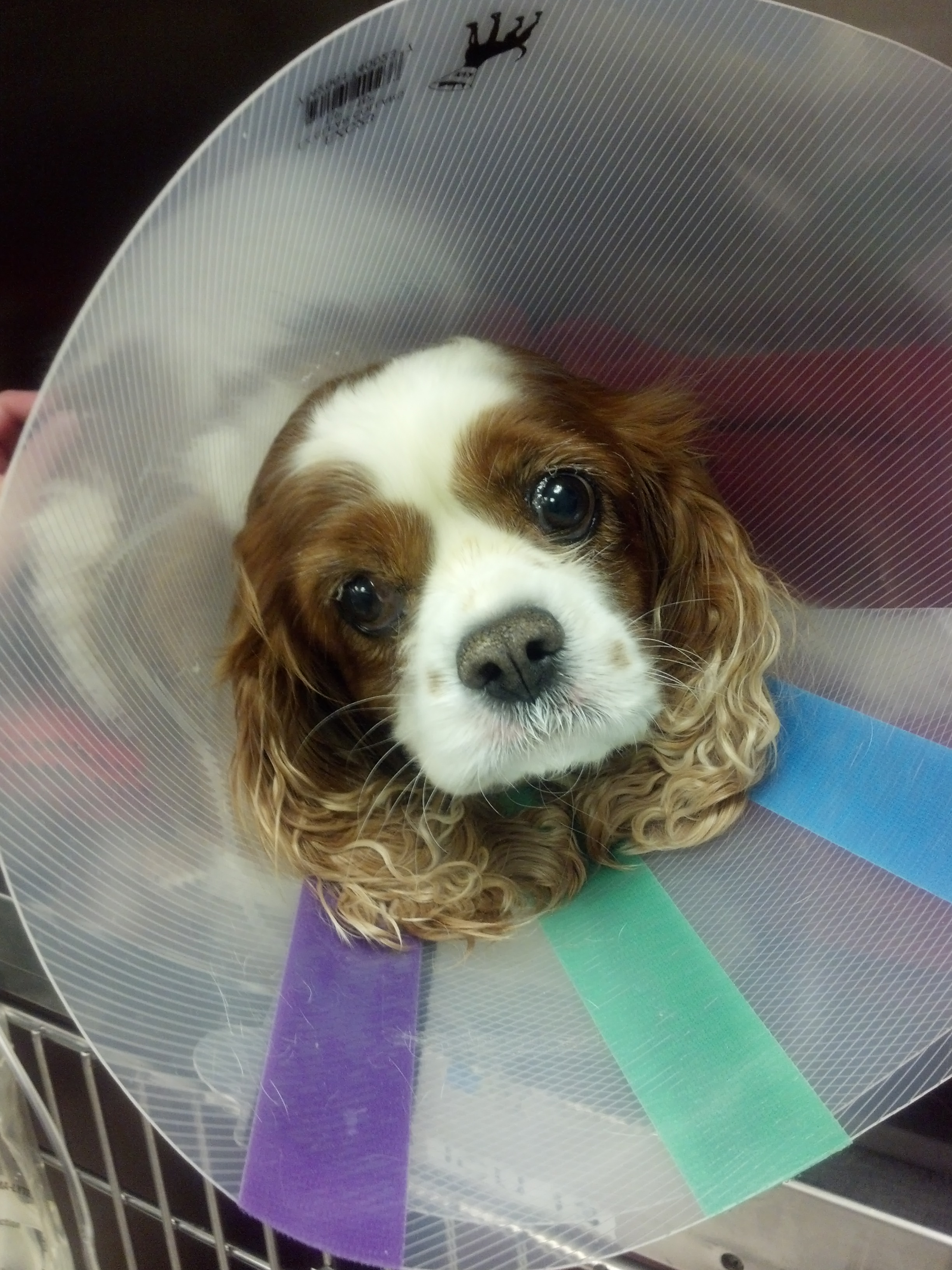Dr. Phil Zeltzman’s Blog
5 New Year resolutions for dogs
Dear Human,
This is your dog writing*.
With the start of the New Year, I thought I would send you a few suggestions to make sure I maintain my place as leader of the pack. I was made to be catered to, and this is how we should keep it this year.

1. Play with me every day
Please don’t just open the door to “let me out.” It’s so boring out there without you. Join me and play with me. Throw me a ball. Run with me. Play hide and seek. There are so many fun things we can do together!
Do this every day, and I promise I will entertain you, make you smile, and lower your blood pressure. Besides, I hear it’s great exercise, and we could all afford to lose an ounce or two after the holidays.
2. Help me love the car
I overheard that not vomiting in the car is my ticket to getting out of the house more frequently. I would love to get out of the house, and be transported by a chauffeur as I deserve. But I hate the car. Help me change that. Help me love car rides, and I promise I won’t hide and fight you every time. Talk to my vet to give me an anti-vomiting medication. I’d rather swallow a pill that than feel nauseous and vomit. And let’s take it slow. Let’s start with short rides, just for fun. Then we can make the car ride longer.
3. Take me on a walk
Let’s walk in the park from now on. The yard is getting so boring… And let’s go to a different park every once in a while. Or a forest. Or the fields or something!
People will fawn all over me because seeing someone like me on a leash will be a treat for humans. Think of all the petting and attention!
4. Teach me a trick
Keep my brain active by teaching me new tricks. I can show your friends how smart I really am and make you proud of being owned by me. You’ve always suspected that I understand every word you are saying, so allow me to prove it by letting me learn new tricks.
5. Take better care of Me
Measure what I eat. Schedule an appointment with my vet if I haven’t been there in the past 6 months. I wouldn’t want to be accused of being chubby or having fleas. Also help me keep my pearly whites in good condition! Preventive health care is the secret to a long and happy life, and only you can help me achieve that.
Help me make 2015 the year I remain the leader of the pack. Help me reclaim my well-deserved place in the world. Help me make this dream a reality. So please do your part and follow these 5 simple steps* to keep me happy, healthy, and deservedly pampered!
Until next time,
Phil Zeltzman, DVM, DACVS, CVJ
* These 5 New Year resolution are loosely inspired from similar information provided on cats by the CATalyst Council, an organization dedicated to cat health and welfare. Find more information at catalystcouncil.org.

Dr. Phil Zeltzman is a traveling veterinary surgeon in Pennsylvania & New Jersey. An award-winning author, he loves to share his adventures in practice along with information about vet medicine and surgery that can really help your pets. Dr. Zeltzman specializes in orthopedic, neurologic, cancer, and soft tissue surgeries for dogs, cats, and small exotics. By working with local family vets, he offers the best surgical care, safest anesthesia, and utmost pain management to all his patients. Sign up to get an email when he updates his blog, and follow him on Facebook, too!
5 New Year resolutions for cats
Dear Human,
This is your cat writing*.
With the start of the New Year, I thought I would send you a few suggestions to get me closer to the status we felines once held in ancient Egypt. We were worshiped as gods, and this is the status I would like to return to this year.

1. Play with me every day
Some people who are owned by a cat think that we don’t need that much attention. I beg to differ. We need lots of attention. We felines crave attention. And we deserve attention. So play with me – every day. In the process, I will entertain you, make you smile, and lower your blood pressure. Besides, I hear it’s great exercise, and we could all afford to lose an ounce or two after the holidays.
2. Help me love my carrier
I overheard that my carrier is my safe ticket to getting out of the house more frequently. I would love to get out of the house, and be transported by a chauffeur as I deserve. But I hate my crate. Help me change that. Help me love my crate, and I promise I won’t hide and fight you every time. Here is a video you can learn from: https://www.catalystcouncil.org/resources/health_welfare/cat_carrier_video/index.aspx
3. Take me on a walk
Dogs should not be the only ones allowed to be walked outside. As long as you don’t interrupt my nap, teach me to walk on a leash, with a kitty harness. First let’s do that inside so I get used to the idea. Then maybe you can walk me in the yard, and possibly even on a sidewalk if you feel it’s clean and safe enough for someone of my status.
Your friends and neighbors will fawn all over me because seeing a cat on a leash is such a rare treat for humans. Think of all the petting and attention!
4. Teach me a trick
In an effort to elevate my status, I am willing to prove that I am smarter than dogs. Teach me tricks and I will show you how smart I really am. You’ve always suspected that I understand every word you are saying, so allow me to prove it by letting me learn a trick.
5. Take better care of Me
Measure what I eat. Schedule an appointment with my vet if I haven’t been there in the past 6 months. I wouldn’t want to be accused of feline obesity or diabetes. Also help me keep my pearly whites in good condition! Preventive health care is the secret to a long and happy life, and only you can help me achieve that.
Help me make 2015 the year I begin elevating my status in your house. Help me reclaim my well-deserved place in the world. Help me make this dream a reality. So please do your part and follow these 5 simple steps* to keep me happy, healthy, and deservedly revered!
Until next time,
Phil Zeltzman, DVM, DACVS, CVJ
* These 5 New Year resolution are loosely inspired from information provided by the CATalyst Council, an organization dedicated to cat health and welfare. Find more information at www.catalystcouncil.org.

Dr. Phil Zeltzman is a traveling veterinary surgeon in Pennsylvania & New Jersey. An award-winning author, he loves to share his adventures in practice along with information about vet medicine and surgery that can really help your pets. Dr. Zeltzman specializes in orthopedic, neurologic, cancer, and soft tissue surgeries for dogs, cats, and small exotics. By working with local family vets, he offers the best surgical care, safest anesthesia, and utmost pain management to all his patients. Sign up to get an email when he updates his blog, and follow him on Facebook, too!
What should you do if your pet gets lost?
One of the most traumatic events a pet owner can go through is having a pet on the run.

Think it could never happen to your pet? Many smart and loving pet owners did before…
Yet many un-sterilized pets run away, (mis)guided by hormones. And as many as 20% of pets, end up MIA after being scared by loud noises such as thunderstorms or fireworks.
Here are 10 tips to help you find your pet ASAP:
- File a “lost pet” report with every rescue organization, every shelter and every animal control office within a 60-mile radius of your home. Also make a point of visiting all nearby shelters every day.
- Alert all veterinary clinics, both day practices and emergency clinics, in your area. Prepare a flier to be posted at the front desk. It’s not uncommon that people bring a stray dog or cat to their family vet, no matter how far from where the animal was found.
- Several times per day, walk around and/or drive around your neighborhood. Ask friends and family members to help out.
- Alert everybody you meet. Pet owners especially will be sensitive to your situation.
- Give anybody who is willing to help a recent picture of your pet and your contact information.
- Post flyers everywhere: all over the neighborhood (telephone poles etc), as well as in private and public locations (businesses, stores, post office…).
- Slick trick: to avoid scams, leave out one characteristic when you describe your pet. If someone calls and claims to have seen your pet, ask them to describe the missing item.
- Use the Internet. There are several pet recovery websites such as FidoFinder.com, TheCenterForLostPets.com and Craigslist.org.
- If you don’t have the time to do all of the above, or can’t take off work easily, consider using a lost pet recovery service. They will contact neighbors, vets, shelters and other organizations – for a fee.
- Just in case your pet comes back home when (s)he is hungry or thirsty, you could place food and water around your home. You could even place the bowls in a (humane) pet trap to catch them.
- Bonus tip: use social media. Facebook, Twitter and texting can be good ways to spread the word quickly.
Bottom line: The first few hours are critical. You need to put in place all of these strategies. But you just can’t do it all by yourself, so enroll help. Get the word out quickly. Never give up. It’s a cruel world out there… and your mission is to save your pet.
The information above is loosely borrowed (with permission) from our colleagues at DVM360, a professional magazine.
I would like to add a few important points: what should you do to prevent your pet from getting lost?
• Take pet identification seriously. A name tag on a collar is a minimum. It should have your pet’s info, your vet’s info, and yours. Of course this doesn’t do any good if the collar is not around your pet’s neck.
A tattoo can be done by your vet (under anesthesia). The best solution is a microchip. This is a tiny electronic device, about the size of a grain of rice, that is implanted under the skin. It can be done awake – anytime.
When a lost pet is found at a shelter or a vet clinic, the first thing people do is “scan” the pet to see if there is a microchip. As long as the microchip is linked to a CURRENT address and phone number (hint, hint), you should get a call with the good news. PLEASE microchip your pets.
• If you allow your pet to be unsupervised in the yard, make sure the fence is 100% secure.
• Don’t trust electric fences 100%. An excited dog can run right through them. However, once on the other side, they may not want to be “shocked” again, so they may remain outside the perimeter. Oh, which reminds me: several of my clients dearly regretted not having the special collar around their dog’s neck the day they were hit by a car. If you go through the expense of installing an electric fence, then please always put the collar on your dog’s neck every time (s)he goes outside. One exception is all it takes…
• ALWAYS walk your dog on a leash. If you are a long-time reader, you surely have read countless stories of pets who have been hit (or worse) by a car. This is a DAILY occurrence in my practice.
• In my opinion as a surgeon who has seen countless horrifying injuries, I would never, ever let a cat outside. My cats are banned from the outside world, and they are perfectly happy indoors.
• Freedom is a wonderful concept… until somebody gets hurt, or until the teary owner realizes that they just can’t afford a 2-3-4-5 thousand dollar bill at the vet.
• Be especially careful and secure the house (doors, gates, windows) when there are fireworks (July 4th, New Year’s Eve etc), around Halloween (especially if you have a black cat) and when you hear thunder.
As in many endeavors, prevention is easier than the “treatment.” You now have a script to prevent your pet from running away. And if you are if this unfortunate situation, or know somebody who is, you have some tips to get your pet back home.
Good luck.
Until next time,
Phil Zeltzman, DVM, DACVS, CVJ

Dr. Phil Zeltzman is a traveling veterinary surgeon in Pennsylvania & New Jersey. An award-winning author, he loves to share his adventures in practice along with information about vet medicine and surgery that can really help your pets. Dr. Zeltzman specializes in orthopedic, neurologic, cancer, and soft tissue surgeries for dogs, cats, and small exotics. By working with local family vets, he offers the best surgical care, safest anesthesia, and utmost pain management to all his patients. Sign up to get an email when he updates his blog, and follow him on Facebook, too!
Halloween special: 10 grossest things at the vet’s
This is a Halloween special, so this is not for the faint of heart. You have been warned…
READER’S DISCRETION IS ADVISED!!!

Some people think that vets and techs are so lucky because they get to cuddle with cute puppies and kittens all day. While this is sometimes true, there is also the less glamorous part of our job: dealing with smells and sights that can make the toughest of the toughest sick to their stomach…
Is your stomach ready to take a tour of the 10 grossest things we see or smell at vet hospitals? Then read on…
1. Maggots
Maggots are certainly one thing that can make my very toughest nurses physically sick. Some of them can’t even look at them.
The little squirmy, flesh-eating fly babies hatch out of eggs laid by flies in open wounds or near body orifices. They show up quickly and can smell terrible because the flesh they live off is usually dead or dying…
2. Proptosed eye
A proptosed eye is when an eye literally pops out of its socket. It is usually still connected by the strong optic nerve, but it is quite a horrifying scene. The most commonly affected breeds are those with bulgy eyes.
3. Cuterebra
Cuterebra is a type of bot fly which can travel through an animal’s body, then burrow just under the skin until it is ready to turn into its adult form. It then comes out of the skin and flies away. And the wonderful circle of life continues… Cuterebra requires a quick surgery to be removed.
4. Open wounds
Open wounds and broken legs can be really nasty after a pet gets hit by a car. One of the worst wounds is called a “degloving injury,” because the skin is literally peeled back or off of the underlying muscle.
Broken legs are very common in our surgery world, however the really disturbing ones are ones that are literally twisted or rotated completely or that is hanging and flopping around.
5. Dehiscence
You know how most vets recommend confinement and a plastic cone (aka E collar – see picture above) after surgery? Well it’s not to torture your pet! It is to prevent them from licking and chewing at the incision and to prevent failure of the surgery. One of the grossest complications after belly surgery is called dehiscence, which at worst could cause the intestines to end up on your favorite carpet…
6. Anal glands
Anal gland fluid is an incredibly foul smelling liquid which vets and technicians empty multiple times a day. We are probably all familiar with the smell, but it never fails to shock you with it’s intensity and foulness when you walk into a room after a dog had their anal glands expressed, and even worse, some patients will release them on their own when they are excited or worked up and it shoots, sometimes onto someone’s skin or clothes!
7. Parasites
Pets can have multiple “external” parasites on their skin and in their ears. Ear mites, fleas and ticks sound gross enough as it is… but it’s even worse when you look at them under the microscope!
When blown up by the magnification of the microscope, these nasty multi-legged parasites look like mini-monsters!
8. HGE
HE or Hemorrhagic Gastro-Enteritis causes an impressive amount of stinky, bloody, jelly-like diarrhea. And it’s even nastier to clean! We’re not quite sure what causes it, and with proper care, it is typically self-limiting. This means that we typically achieve a happy outcome in the end.
9. Coprophagia
Yes… some of our beloved dogs have this nasty habit of eating poop. Dog poop, deer poop, rabbit poop, horse poop, cat poop, some are not even very discriminating…
And then some insist on giving us doggy kisses! Let’s be serious!
10. Rotten mouth
Some pets have a mouth that is so rotten that you can smell them from the next room. Under a large build-up of tarter, bacteria, pus, infected bone and gingivitis are teeth that are sometimes so loose that we can pull them with our bare hands! Please believe your vets when they recommend a dental cleaning. Some dogs need one every few years, but some need a cleaning once a year, or sometimes even every 6 months.
This list is hardly exhaustive, but it gives you a brief overview of what sometimes happens behind the scene at your favorite veterinary clinic…
Until next time,
Phil Zeltzman, DVM, DACVS, CVJ

Dr. Phil Zeltzman is a traveling veterinary surgeon in Pennsylvania & New Jersey. An award-winning author, he loves to share his adventures in practice along with information about vet medicine and surgery that can really help your pets. Dr. Zeltzman specializes in orthopedic, neurologic, cancer, and soft tissue surgeries for dogs, cats, and small exotics. By working with local family vets, he offers the best surgical care, safest anesthesia, and utmost pain management to all his patients. Sign up to get an email when he updates his blog, and follow him on Facebook, too!
Lyme disease is just the beginning…
Greetings from China, where I was invited to lecture!
If you own a dog, you surely have heard about Lyme disease. But are you aware that there are other diseases transmitted by ticks? Let’s review the 5 most common “tick-borne diseases” in dogs.

1. “Lyme” (and not Lyme’s) is a disease transmitted by ticks. It can cause limping and fever. A minority of dogs can get severe kidney disease, which can be life-threatening. Fortunately, Lyme disease can be treated successfully with the proper antibiotics. But Lyme is just one disease transmitted by ticks. Here are 4 other, lesser known diseases that are also transmitted by ticks.
2. Hemoplasma (Hemoplasmosis) Previously called Hemobartonellosis, this disease exists in cats and dogs. It it transmitted by ticks and occasionally by fleas. It cases anemia (low red blood cell count), especially in pets who have a weak immune system.
3. Bartonella (Bartonellosis) This disease can occur in cats and dogs after being bitten by fleas and occasionally by ticks. It can cause lameness, a stiff gait or heart disease in dogs.
4. Babesia (Babesiosis) This disease can occur in cats and dogs after being bitten by a tick… or a dog. It can cause anemia (low red blood cell count), a low platelet count and increased protein levels in the blood. It can rarely cause kidney disease.
5. Rickettsia (Rickettsiosis) Rickettsia is a type of bacteria, which can in fact include several types: Ehrlichia (Ehrlichiosis) or Anaplasms (Anaplasmosis). They can cause limping, fever, bleeding (because of a low platelet count), anemia (low red blood cell count).
What is frustrating with these diseases is that it can be difficult to diagnose them by testing the blood. In addition, it’s tough for the vet to decide if it should be treated with antibiotics or not. The reason is that many pets are “carriers” which have no symptoms at all. As always, the best way to avoid any of these diseases is prevention, which include serious tick (and flea) protection.
Please talk to your family vet about the best way to do that in YOUR area.
Until next time,
Phil Zeltzman, DVM, DACVS, CVJ

Dr. Phil Zeltzman is a traveling veterinary surgeon in Pennsylvania & New Jersey. An award-winning author, he loves to share his adventures in practice along with information about vet medicine and surgery that can really help your pets. Dr. Zeltzman specializes in orthopedic, neurologic, cancer, and soft tissue surgeries for dogs, cats, and small exotics. By working with local family vets, he offers the best surgical care, safest anesthesia, and utmost pain management to all his patients. Sign up to get an email when he updates his blog, and follow him on Facebook, too!

